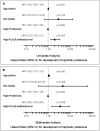PLA2R antibody levels and clinical outcome in patients with membranous nephropathy and non-nephrotic range proteinuria under treatment with inhibitors of the renin-angiotensin system
- PMID: 25313791
- PMCID: PMC4197007
- DOI: 10.1371/journal.pone.0110681
PLA2R antibody levels and clinical outcome in patients with membranous nephropathy and non-nephrotic range proteinuria under treatment with inhibitors of the renin-angiotensin system
Abstract
Patients with primary membranous nephropathy (MN) who experience spontaneous remission of proteinuria generally have an excellent outcome without need of immunosuppressive therapy. It is, however, unclear whether non-nephrotic proteinuria at the time of diagnosis is also associated with good prognosis since a reasonable number of these patients develop nephrotic syndrome despite blockade of the renin-angiotensin system. No clinical or laboratory parameters are available, which allow the assessment of risk for development of nephrotic proteinuria. Phospholipase A2 Receptor antibodies (PLA2R-Ab) play a prominent role in the pathogenesis of primary MN and are associated with persistence of nephrotic proteinuria. In this study we analysed whether PLA2R-Ab levels might predict development of nephrotic syndrome and the clinical outcome in 33 patients with biopsy-proven primary MN and non-nephrotic proteinuria under treatment with blockers of the renin-angiotensin system. PLA2R-Ab levels, proteinuria and serum creatinine were measured every three months. Nephrotic-range proteinuria developed in 18 (55%) patients. At study start (1.2±1.5 months after renal biopsy and time of diagnosis), 16 (48%) patients were positive for PLA2R-Ab. A multivariate analysis showed that PLA2R-Ab levels were associated with an increased risk for development of nephrotic proteinuria (HR = 3.66; 95%CI: 1.39-9.64; p = 0.009). Immunosuppressive therapy was initiated more frequently in PLA2R-Ab positive patients (13 of 16 patients, 81%) compared to PLA2R-Ab negative patients (2 of 17 patients, 12%). PLA2R-Ab levels are associated with higher risk for development of nephrotic-range proteinuria in this cohort of non-nephrotic patients at the time of diagnosis and should be closely monitored in the clinical management.
Conflict of interest statement
Figures




References
-
- Cattran D (2005) Management of membranous nephropathy: when and what for treatment. J Am Soc Nephrol 16: 1188–1194. - PubMed
Publication types
MeSH terms
Substances
LinkOut - more resources
Full Text Sources
Other Literature Sources

